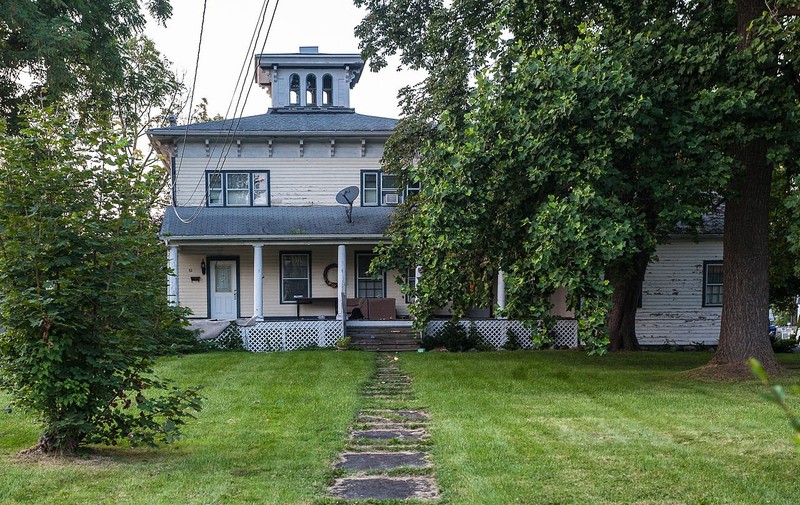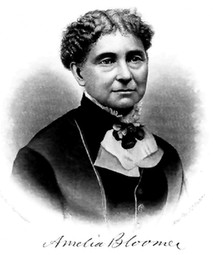Amelia Bloomer House
Introduction
Text-to-speech Audio
This historic home is significant for being the home of Amelia Bloomer (1818-1894), one of the leading women's rights advocates of the 19th century. She was also a supporter of the temperance movement, which was the movement against consuming alcohol, and the first woman to own and operate a newspaper, which was called The Lily. Bloomer was also known for her association with lower body garments called pantaloons worn by women in the 1850s. They were less cumbersome than traditional women's clothing of the day. She did not invent them but promoted them in her newspaper so as a result, they were called "bloomers." The house itself was originally built in 1830 in the Greek Revival style and was later enlarged and converted to the Italianate style in the 1850s. Apparently, Bloomer only lived in the house for just six months in 1840 after she got married. The home appears to be a private residence but can be viewed from the street.
Images
The historic Amelia Bloomer House was built in 1830 then expanded in the 1850s.

Amelia Bloomer (1818-1894)

This image shows a woman wearing a pantaloon garment called a bloomer.

Backstory and Context
Text-to-speech Audio
The house was added to the National Register of Historic Places in 1980 for its architecture and association with Amelia Bloomer. There is evidence that suggests it was a terminus of the Underground Railroad. Unfortunately, more information about this isn't readily available.
Amelia Bloomer grew up in Homer, New York. Although her education was limited to a few years, she was able to become a teacher at the age of 17. In 1840, she met and married a man named Dexter Bloomer, who ran a newspaper called the Seneca Falls County Courier. They moved to Seneca Falls where she became involved in local activism. Dexter suggested she begin to write columns in the paper, which earned her notoriety among the activist community.
After she started writing for the paper, Dexter was elected postmaster. He appointed her as his assistant. This enabled her to make her office the unofficial headquarters of the town's women's rights movement. Her adoption and promotion of bloomers, which came to symbolize the movement, garnered criticism from both conservative men and women.
She supported women's rights in general, but the primary thrust of her activism was temperance (she also strongly supported suffrage). She did attend the 1848 Seneca Falls Convention (the first women's rights convention in the country) but did not sign the Declaration of Sentiments, which was the document stating the convention's resolutions. Her unwavering commitment to temperance was not shared by other women activists, who thought other causes of the women's rights movement were more important. In 1851, she introduced Elizabeth Cady Stanton to Susan B. Anthony, which started the decades-long partnership between the two women.
Amelia and Dexter moved to Iowa in 1854. A year earlier she sold The Lilly, as it was too difficult to manage. In Iowa, she was president of the Iowa Woman Suffrage Association between 1871-1873. She continued to advocate for women's rights until she died in 1894 at the age of 76. She is buried in Council Bluffs, Iowa. Dexter published a compilation of Amelia's writings in 1895 (see link below).
Amelia Bloomer grew up in Homer, New York. Although her education was limited to a few years, she was able to become a teacher at the age of 17. In 1840, she met and married a man named Dexter Bloomer, who ran a newspaper called the Seneca Falls County Courier. They moved to Seneca Falls where she became involved in local activism. Dexter suggested she begin to write columns in the paper, which earned her notoriety among the activist community.
After she started writing for the paper, Dexter was elected postmaster. He appointed her as his assistant. This enabled her to make her office the unofficial headquarters of the town's women's rights movement. Her adoption and promotion of bloomers, which came to symbolize the movement, garnered criticism from both conservative men and women.
She supported women's rights in general, but the primary thrust of her activism was temperance (she also strongly supported suffrage). She did attend the 1848 Seneca Falls Convention (the first women's rights convention in the country) but did not sign the Declaration of Sentiments, which was the document stating the convention's resolutions. Her unwavering commitment to temperance was not shared by other women activists, who thought other causes of the women's rights movement were more important. In 1851, she introduced Elizabeth Cady Stanton to Susan B. Anthony, which started the decades-long partnership between the two women.
Amelia and Dexter moved to Iowa in 1854. A year earlier she sold The Lilly, as it was too difficult to manage. In Iowa, she was president of the Iowa Woman Suffrage Association between 1871-1873. She continued to advocate for women's rights until she died in 1894 at the age of 76. She is buried in Council Bluffs, Iowa. Dexter published a compilation of Amelia's writings in 1895 (see link below).
Cite This Entry
M., Ben. "Amelia Bloomer House." Clio: Your Guide to History. January 2, 2019. Accessed March 20, 2025. https://theclio.com/tour/1962/12
Sources
Ackerson, Anne. "Amelia Bloomer House." Building Structure Inventory Form - Division for Historic Preservation, New York State Parks and Recreation. August, 1978. https://npgallery.nps.gov/GetAsset/0bbfc3be-3f52-4d1b-adeb-597447c04305.
Norwood, Arlisha R. "Amelia Bloomer (1818-1894)." National Women's History Museum. Accessed January 2, 2019.
https://www.womenshistory.org/education-resources/biographies/amelia-bloomer.
Photos: Wikimedia Commons
Norwood, Arlisha R. "Amelia Bloomer (1818-1894)." National Women's History Museum. Accessed January 2, 2019.
https://www.womenshistory.org/education-resources/biographies/amelia-bloomer.
Photos: Wikimedia Commons

